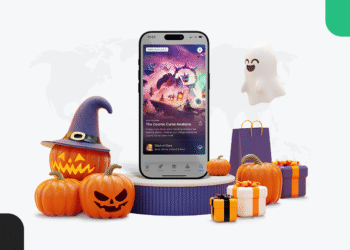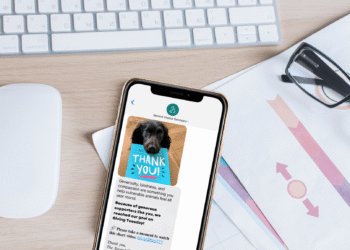
Speed and accessibility can make or break a sale. Customers expect instant, convenient communication, and if you’re not reaching them where they spend most of their time, you’re losing opportunities.
That’s why SMS continues to be one of the highest-ROI sales channels, offering unmatched open rates, rapid response times, and the ability to deliver a personal touch at scale.
In this guide, you’ll discover the strategic foundations of an effective SMS sales plan and six proven actionable methods to help you close more deals faster. Let’s get started.
Why SMS is a sales powerhouse
Traditional sales strategies often rely on face-to-face conversations or phone calls to connect with customers. While these channels have their merits, they may not always resonate with all individuals, especially considering demographics and personal preferences.
With the emergence of SMS marketing, sales teams can revolutionize their approach and effectively engage with a broader audience. Text messages offer a unique opportunity to reach those who may not prefer in-person interactions or feel uncomfortable with the pressure of a phone call.
By leveraging sales SMS, businesses can access a new avenue of communication that is convenient, nonintrusive, and tailored to modern consumers’ preferences.
The advantages of using SMS for sales and customer engagement are numerous, including:
- High open rates and instant reach: With 92% of users still opening SMS according to our latest U.S. consumer survey and messages typically read within minutes, sales teams can deliver time-sensitive updates, offers, and reminders with confidence that they’ll be seen almost instantly.
- Direct personal connection: SMS allows sales teams to personalize their outreach by using a customer’s name, referencing past interactions, or tailoring offers to their preferences. Combined with customer data from tools like a Composable CDP, this personalization can feel authentic and relevant, strengthening the customer relationship.
- Integration with other marketing channels: SMS works even better when combined with email campaigns, WhatsApp messages, Instagram DMs, Messenger chats, or live website chat tools. This multi-channel approach ensures prospects can connect with your brand on their preferred platform and move seamlessly through the sales journey.
- Cost-effectiveness with high ROI: Compared to print or television ads, SMS offers low setup costs, no ongoing fees, and a strong return on investment, helping teams hit their targets without overspending.
- Convenience for the customer: SMS fits naturally into daily life, allowing customers to engage without disrupting their schedules.
- Timely and relevant communication: Whether it’s a follow-up, a limited-time offer, or an urgent update, SMS ensures messages reach people wherever they are right when it matters most.
Recent statistics have shown that 91% of consumers opt in to receive texts from businesses, and the average conversion rate for SMS marketing ranges between 20% and 30%, depending on the industry and campaign specifics.
These numbers prove that SMS isn’t just a communication tool, it’s a revenue driver. By aligning sales and support strategies with these consumer habits, companies can maximize engagement and close more deals without adding friction to the customer journey.

How to prepare your SMS sales strategy
Before launching a text messaging sales campaign, it’s important to lay the groundwork. A successful text marketing strategy doesn’t just happen; it’s built on several essential pillars. Here’s what you need to know before getting started.
Understand your audience & segment lists
Not every customer responds to the same offer or tone. Start by reviewing your existing customer data, such as purchase history, engagement patterns, location, and preferences, and group your audience into targeted contact segments.
For example, you could create one list for new leads, another for repeat buyers, and a VIP roster for your most loyal customers. Segmentation allows you to send highly relevant offers that resonate on a personal level, improving open rates, engagement, and sales.
Align SMS campaigns with overall sales goals
An effective SMS sales campaign is tied to measurable objectives. Are you aiming to generate new leads, recover abandoned carts, upsell premium products, or re-engage dormant customers?
Defining your sales goals ensures your SMS messages are focused and consistent with other marketing efforts, whether that’s email campaigns, social media ads, or in-store promotions. This alignment helps create a seamless brand experience across all customer touchpoints.
Craft compelling short-form sales copy
The character limit in SMS forces you to be concise, but that’s an advantage because your message will be quick to read and hard to ignore. Focus on a single clear offer with a strong call-to-action.
Use urgency and exclusivity sparingly but strategically to encourage immediate action. Personal touches like using the recipient’s name or referencing their last purchase can make the message feel more genuine and relevant.
Respect compliance & opt-in best practices
Before sending a single message, make sure each recipient has explicit opt-in permission. This isn’t just good manners; it’s required under texting regulations like GDPR, TCPA, and similar laws worldwide.
Provide an easy way for customers to opt out at any time. Being transparent about how you’ll use their information and respecting their preferences builds trust and protects your brand’s reputation.
Maximize with proven SMS sales techniques
Once the foundations are in place, use proven techniques to boost results:
- Cross-selling: Send tailored suggestions for related products shortly after a purchase to increase order value.
- Upselling: Offer upgrades or premium versions to customers who’ve shown interest in similar items.
- Lead generation via opt-ins: Use compelling incentives like exclusive deals or early access to encourage people to join your SMS list.
Pairing these tactics with other channels such as email campaigns, WhatsApp, Instagram DMs, and Messenger can amplify your reach and create a seamless customer journey.

6 SMS sales techniques to turn customers into buyers
The techniques below are practical for small business owners, e-commerce retailers, marketing teams, entrepreneurs, and app developers. They can help you attract new subscribers, convert new customers, and scale SMS campaigns efficiently.
1. Make your website mobile-ready for SMS campaigns
A mobile-friendly website is an absolute necessity as far as mobile sales are concerned. The reason is that people are more likely to make a purchase when they can navigate your website with little or no assistance at all. Otherwise, they will leave your site with an unpleasant shopping experience and may never return.
Start by incorporating a responsive UX design into your website that allows it to automatically adjust to the user’s screen size and orientation for better viewing. This improves readability, increases customers’ time on your website, and enhances the overall customer experience.
You should also improve your website-loading speed. A one-second delay in mobile load time decreases conversion rates by 20%. Fortunately, you can use Google’s Page Speed Insights to run a diagnostic on your website and fix all speed issues.
Keep content simple and concise, including your navigation menu. With mobile devices having smaller screens, it can be difficult for users to read long or large blocks of text. Your website content should be skimmable and visually appealing, with short sentences, paragraphs, headers, and a hamburger menu.
Finally, pop-ups are intrusive and can put customers off when accessing your web pages. So, whether the pop-ups are sponsored ads or contain useful information for the user, it’s best to make them subtle.

2. Boost engagement with a mobile shopping app
Implementing a mobile app opens you up to new markets of mobile users. It also provides potential customers with a dedicated channel to engage with your products and services, eliminating the need to visit a physical store or rely solely on your website.
When developing a dedicated mobile app to facilitate sales, take note of the following best practices:
- Leverage mobile gestures like swipe, pinch-to-zoom, and long press.
- Design the app with assistive technologies for users with disabilities.
- Incorporate iterative yet responsive designs that you can scale.
- Optimize the app for fast and efficient performance.
- Utilize a user-centric approach in the development process.
- Prioritize users’ security and privacy.
- Provide updates and fix bugs regularly.
Remember the importance of maximizing your app’s visibility and downloads through App Store Optimization (ASO). Strategies like keyword optimization, compelling titles, visuals, and positive reviews significantly boost discoverability.
3. Drive sales with targeted SMS marketing
With high open rates, text message marketing is one of the most effective ways to boost mobile sales. Sales text messages reach any phone instantly, making them perfect for time-sensitive offers.
Whether you send a mass text message or use personalized sales texting, the channel is cost-effective and delivers fast results. You can use it to promote your services and products, send coupon codes, and send reminders for abandoned carts.
4. Streamline purchases with mobile payment links
Mobile payments are on the rise, and smart business owners now embed secure links in SMS messages. This makes it easy for customers to complete a recent purchase or move seamlessly to their next purchase without leaving the conversation.
Here are a few popular payment link alternatives you can try:
- Apple Pay is exclusively available for all Apple devices. It is intuitive and secure for in-app and web-based payments. Sharing via an SMS payment link provides an intuitive and secure experience for in-app and web-based payments. Apple Pay is free, but users must pay a specific fee for all debit and credit transactions.
- Google Pay allows users to make payments using their credit and debit cards linked to their bank or Google Pay accounts. An SMS payment link can launch Google Pay instantly, making it convenient for Android and iOS users. Google Pay supports transactions in different countries, though available features vary by location.
- PayPal offers a secure and seamless way for businesses to facilitate payments through mobile devices. Including a PayPal link in your SMS lets customers pay on the spot, taking advantage of PayPal’s large user base and wide acceptance. It’s accessible on Android and iOS devices, allows domestic and international transactions, and has fees that vary based on the transaction type and services used.
Other popular options for SMS payment links include Stripe Checkout, Square Online Checkout, Shopify Pay, and Venmo, each offering quick, secure, and mobile-friendly payment experiences.
5. Personalize every message for higher conversions
According to McKinsey’s survey, companies that personalize shopping experiences can drive more sales, turning qualified leads into loyal buyers. By including your business name, sharing helpful information, and using SMS to send messages that feel personal, you’ll spark better customer conversations and encourage both first-time and repeat purchases.
To provide personalized mobile shopping experiences, you must first collect and evaluate customer data. Doing so helps you gather relevant information about customers’ preferences, buying behavior, and expectations. You can collect information through:
- SMS surveys and questionnaires
- Implementing cookies on your websites
- Permission to access specific data
- Social media polls
The next step is adequately utilizing these insights to improve customer experience and drive your desired sales. Here are a few strategies to get you started:
- Provide product or service recommendations based on previous purchases.
- Integrate a cloud contact center and use it to offer real-time customer support.
- Personalize communication with rich templates and dynamic fields.
- Create a reward or loyalty program to increase customer satisfaction.
- Set up self-service options, such as an FAQ section and tutorials.
6. Use timely SMS follow-ups to secure the sale
Following up at the right moment can mean the difference between losing a lead and closing a deal. SMS follow-ups are instant, personal, and hard to miss, making them ideal for many businesses to re-engage prospects.
To create urgency, use them to remind customers about abandoned carts, confirm interest after a sales call, or share limited-time offers. Keep messages short, relevant, and action-oriented, and always include a clear next step, such as a link to complete checkout or book an appointment.
Bonus tips
Even after you’ve mastered the core strategies for SMS sales, there are extra tactics you can use to push your results further. Here are some quick-win ideas:
- Leverage mobile-friendly social media: With nearly 80% of social media time spent on mobile, use platforms like Facebook, TikTok, Twitter, and Instagram to share engaging posts, connect via direct messages, and boost brand visibility.
- Track and improve performance: Monitor open, click-through, and conversion rates; use A/B testing to refine messaging; and analyze customer feedback for new opportunities.
- Overcome common SMS challenges: Partner with a reputable SMS provider such as Textmagic for high deliverability, automate opt-in/out management, and ensure compliance with text messaging laws.

Examples of successful SMS sales strategies
Real-world examples show how businesses use an SMS platform to improve their sales process and customer communication. The following case studies show how businesses in different industries successfully integrated SMS into their sales and communication strategies and achieved impressive results.
Hartfelt Real Estate saw dramatic improvements by centralizing SMS follow-ups through Textmagic. With one system to manage messaging, contacts, templates, and customer replies, the team responded faster, cut days off their lead-to-close timelines, and boosted lead-response rates by over 40%.
Wynter, a B2B research platform, deployed SMS alerts to reach busy professionals directly. These alerts doubled participation rates in their studies compared to email and ensured faster and more reliable engagement from respondents.
These examples prove that SMS isn’t just for marketing; it’s a versatile, results-driven channel that can improve communication speed, increase conversion rates, and boost customer engagement in virtually any industry.
Now that you’ve seen how businesses use SMS to achieve measurable results, let’s look at some ready-to-use sales text message examples you can adapt to your sales campaigns for maximum impact. Relying on ready-made SMS templates, teams can respond faster, guide potential customers, and encourage repeat purchases, all while staying within SMS compliance rules.
Personalized message
Happy birthday, [First Name]! Celebrate with 20% off your next order. Use code BDAY20 at checkout. Shop now: https://www.textmagic.com/blog/boost-sales-sms/.
Abandoned cart reminder
Your cart isn’t going anywhere! Come back and complete your purchase now and get free shipping.
Product launch
Introducing our newest product! Get 10% off your first order of [Product Name] with code NEW10. Shop now: https://www.textmagic.com/blog/boost-sales-sms/.
How Textmagic can help boost your mobile sales

At Textmagic, we’re dedicated to helping businesses like yours leverage the power of SMS to drive sales and efficiently engage with customers. Our SMS platform offers a range of features that make it a powerful tool for increasing sales through:
With the right SMS software, you can handle unlimited contacts, automate replies to a few questions, and deliver a prompt response every time. Start your free trial with Textmagic today and see how SMS can boost sales and streamline workflows.
Ready to boost sales?
Start your SMS campaign with Textmagic today and reach your customers instantly, compliantly, and effectively.

Conclusion
When you combine a clear strategy with proven SMS templates for sales, you unlock a channel that’s fast, personal, and highly effective. Every step works together to convert interest into action, from segmenting your audience and crafting compelling offers to integrating payment links and sending timely follow-ups.
Align your messages with customer preferences and deliver them at the perfect moment. The sooner you start, the sooner you’ll see the difference SMS can make to your bottom line.
Frequently Asked Questions (FAQs)
Selling through SMS starts with getting permission. Customers must opt in before you send any messages. Once you have consent, keep your texts short, direct, and focused on value. Every message should include a clear call to action, like “Reply YES to claim your offer.’’
An SMS marketing strategy is a structured approach to using text messages as a direct communication and promotional channel. It involves identifying your audience, setting campaign goals, crafting message content, and determining optimal send times.
No, but you’re only allowed to perform SMS outreach if the recipient has given clear permission.
Every message should include a simple way to opt out. If someone asks you to stop sending texts and you keep sending them, you could face legal penalties.
SMS marketing has proven a successful tool for many businesses across industries. It often drives strong engagement and helps convert interest into action. Companies use texting services like Textmagic to keep customers informed and reinforce brand loyalty.
The success of SMS marketing depends on factors like message relevance, timing, and respecting user preferences.
Text messages are typically read shortly after delivery, making them suitable for time-sensitive information.















